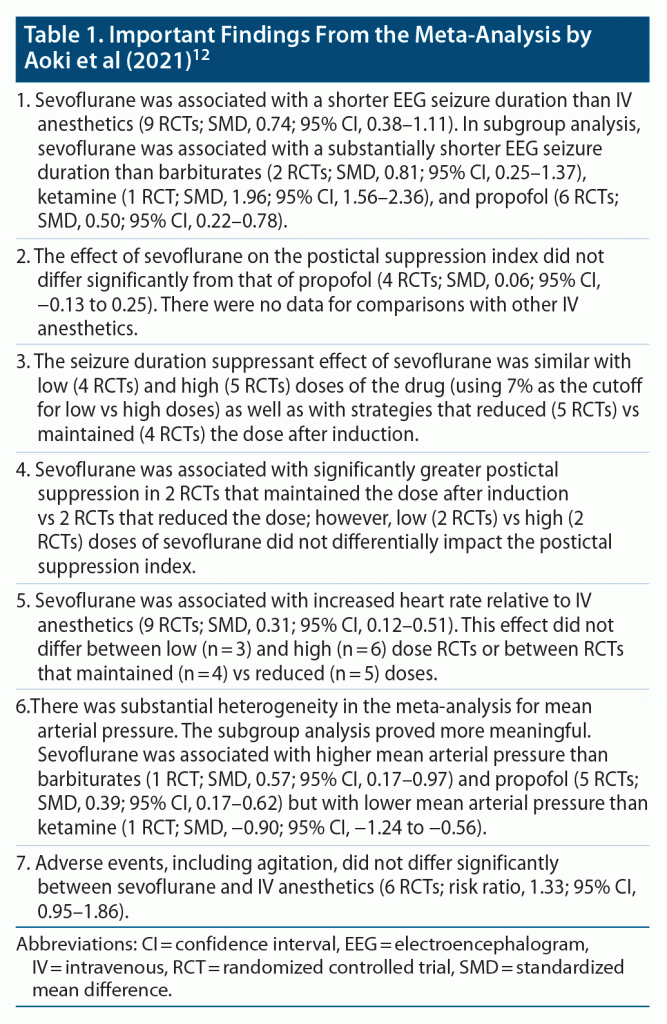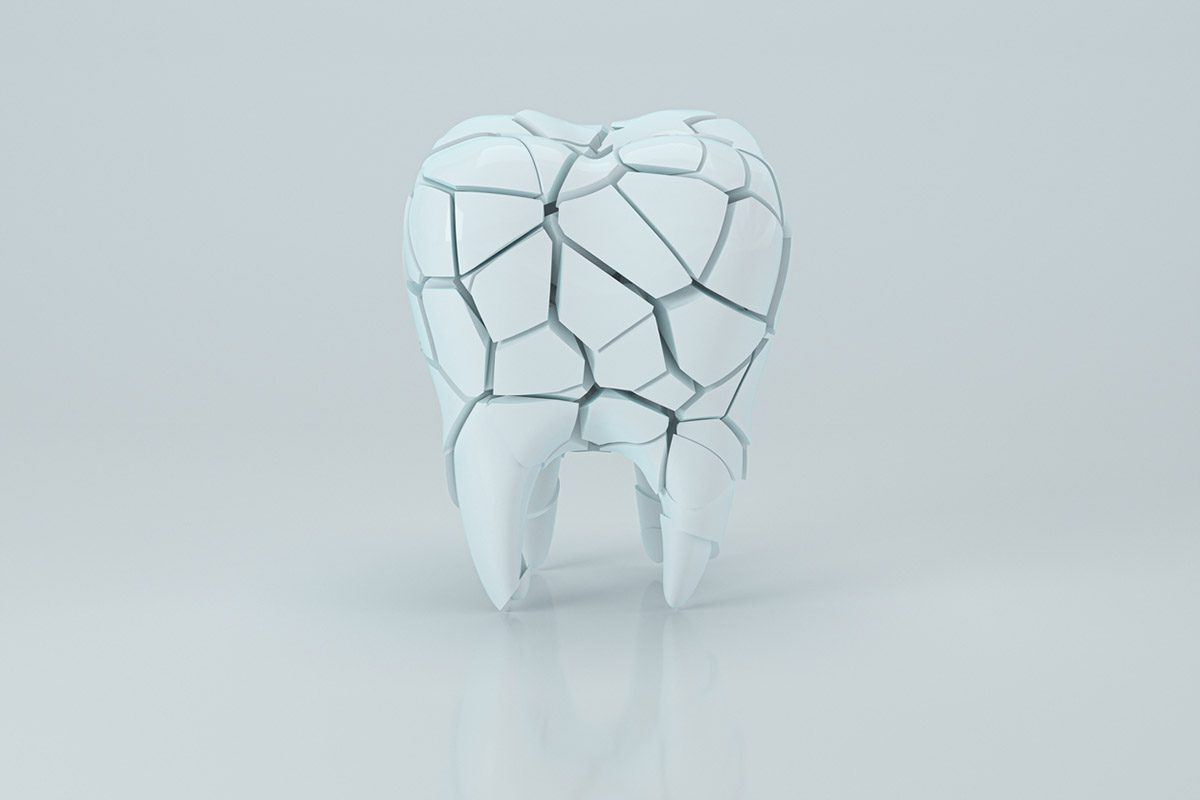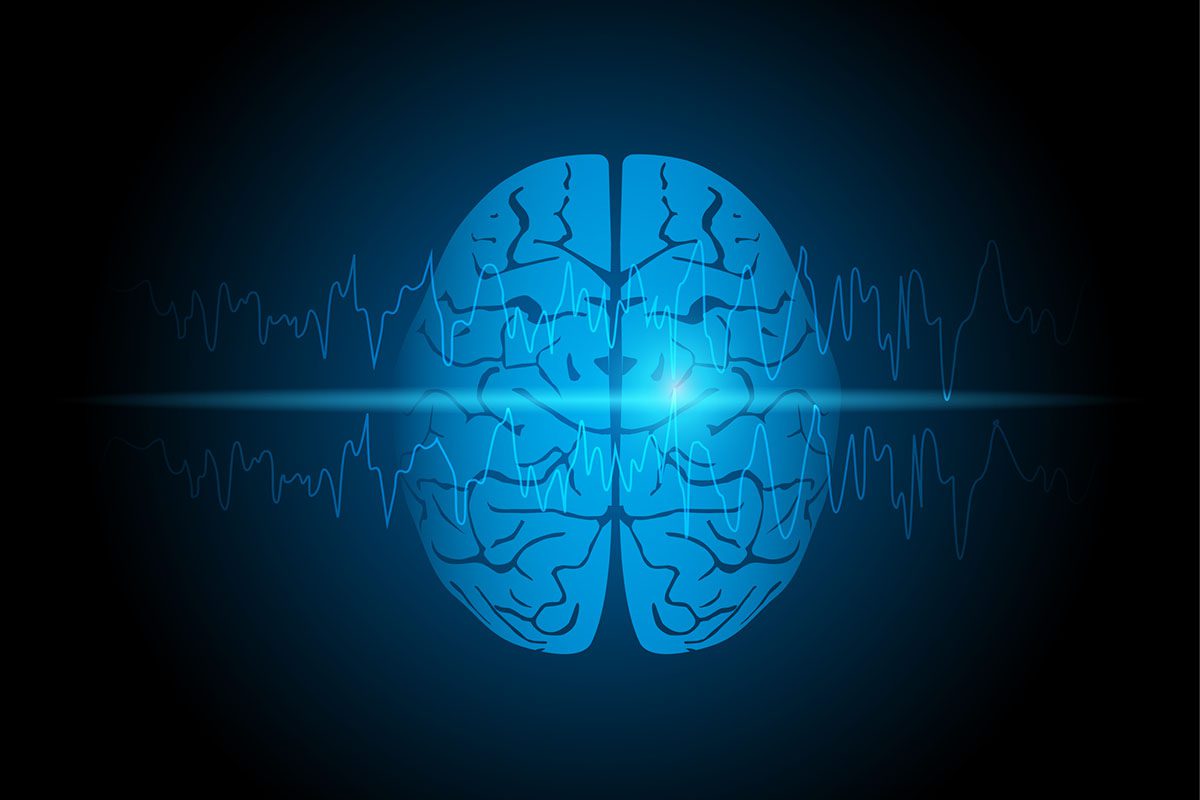ABSTRACT
Anesthesia for electroconvulsive therapy (ECT) usually involves the intravenous (IV) administration of drugs such as methohexital, thiopental, propofol, etomidate, or ketamine. Sevoflurane is an inhalational anesthetic agent that has been available for the past 3 decades. Although many studies have examined sevoflurane in the context of ECT, treatment guidelines make either no mention or only passing mention of its potential use in the ECT procedure. A recent systematic review and meta-analysis identified 12 randomized clinical trials (pooled N = 377) of sevoflurane vs IV anesthetics in patients receiving ECT. The meta-analysis found that sevoflurane was associated with shorter EEG seizure duration than barbiturate, ketamine, or propofol anesthesia; that the postictal suppression index did not differ significantly between sevoflurane and propofol; that sevoflurane increased heart rate more than did the IV anesthetics; that sevoflurane increased mean arterial pressure more than did barbiturates and propofol but less than did ketamine; and that, overall, adverse events did not differ significantly between sevoflurane and IV anesthetics. Other known disadvantages of sevoflurane include the need for additional anesthesia instrumentation, the potentiation of action of nondepolarizing muscle relaxants, and the increased complexity of the ECT procedure. These findings and considerations do not encourage the use of sevoflurane for ECT anesthesia. However, there may be a niche role for sevoflurane in patients who are afraid of needlesticks or who are too agitated for an IV line to be set up while they are conscious and in patients who characteristically experience prolonged ECT seizures. Sevoflurane could also be useful in the final trimester of pregnancy because it may inhibit ECT-induced uterine contractions. Importantly, undesired effects of sevoflurane on seizure duration and the hemodynamic response to ECT can be attenuated by discontinuing its administration after induction.
J Clin Psychiatry 2021;82(4):21f14173
To cite: Andrade C. Anesthesia for electroconvulsive therapy: a niche role for sevoflurane. J Clin Psychiatry. 2021;82(4):21f14173.
To share: https://doi.org/10.4088/JCP.21f14173
© Copyright 2021 Physicians Postgraduate Press, Inc.
Electroconvulsive therapy (ECT) is an important somatic treatment in psychiatry. In ECT, a very small electric current, usually about 0.8A, is passed through the brain for a very short time, usually about a second. This electrical stimulus elicits a seizure with central and peripheral elements. The central element comprises the rhythmic, synchronous neuronal discharges that are characteristic of an epileptic seizure, as detected by electroencephalographic (EEG) recording. The peripheral element comprises the rhythmic, synchronous contractions of skeletal musculature that are characteristic of a tonic-clonic epileptic seizure, as detected by visual observation.1–3
The occurrence of the central seizure is essential to the efficacy of ECT; its adequacy is assessed through EEG recordings. The peripheral seizure, that is, the motor convulsion, is irrelevant to the efficacy of ECT; because it is associated with risks of musculoskeletal and other adverse effects, it is attenuated or abolished by the use of a muscle relaxant drug, usually succinylcholine, administered shortly before the ECT stimulus is passed. The muscle relaxant paralyzes all skeletal muscles, including the muscles of respiration. The experience of complete paralysis can be terrifying to a conscious patient, and so a short-acting anesthetic agent is administered, with the muscle relaxant injected only after the anesthesia has taken effect. This procedure is known as modified ECT; the (peripheral) seizure is modified by the use of a muscle relaxant, and the use of the muscle relaxant necessitates the prior administration of anesthesia.1–3
Anesthesia for ECT: Commonly Used Agents
Methohexital, pentothal, and propofol are the commonest induction agents used as anesthesia for ECT; others include etomidate and ketamine. All of these are administered by intravenous (IV) injection. Methohexital may be associated with fewer cardiovascular risks than pentothal and is associated with fast recovery. Methohexital and propofol are both associated with pain at the time of injection, especially when injected into small veins. Propofol is associated with fast recovery, and with smooth and early recovery of cognitive functions. Propofol is most strongly anticonvulsant and characteristically reduces seizure duration but is associated with less substantial increase in heart rate and blood pressure during the ECT procedure. Pentothal has a longer duration of action than either methohexital or propofol; this prolongs the ECT procedure but reduces the risk of adverse postictal emergent events such as agitation. Etomidate, like methohexital and propofol, may be associated with injection pain. Among all of these agents, etomidate and ketamine have the least effect on seizure parameters. Ketamine may be associated with a slightly faster onset of antidepressant action across the ECT course, but with higher intra-ECT heart rate and blood pressure and a higher risk of adverse postictal emergent events.4–7
Short-acting sedating opioids such as remifentanil or alfentanil may be administered along with the primary anesthetic drug to reduce the dose of the anesthetic drug required to induce anesthesia; this is because methohexital, pentothal, and propofol have anticonvulsant properties that can attenuate seizure quality and thereby potentially attenuate the efficacy of the ECT seizure.8,9 Dexmedetomidine is an α2 adrenoceptor agonist that may likewise be used for an anesthesia-sparing effect; it also attenuates the hemodynamic effects associated with ECT.10
Sevoflurane Anesthesia for ECT
Sevoflurane is a nonpungent, nonirritant, inhalational anesthetic agent that has been available for clinical use for the past 3 decades. Sevoflurane is associated with rapid induction and rapid emergence from anesthesia; the risk of cardiorespiratory adverse effects is low.11 These qualities make sevoflurane potentially suitable for induction of anesthesia in patients receiving ECT. However, although many studies have examined sevoflurane in the context of ECT, major ECT guidelines1–3 make no mention or only passing mention of sevoflurane. In this context, Aoki et al12 described a PRISMA-compliant, PROSPERO-registered systematic review and meta-analysis of RCTs that compared sevoflurane with IV anesthesia for ECT.
These authors12 searched electronic databases and other sources and reported the identification of 12 relevant RCTs (median study sample size, 29; pooled N = 377) that described 1,339 ECT sessions (however, readers may note that the authors’ table that described the included studies listed only 11 studies with a pooled sample size of 381). Nine of the RCTs were crossover studies. None of the RCTs were considered to be at high risk of bias.
The median age of the sample in these studies was 43 years. To the extent that the data were reported in the individual studies, ECT was administered for depression in 71% of the sample, for schizophrenia in 23%, and for bipolar disorder in most of the rest.
A little unusually, the authors named 3 primary outcomes: EEG seizure duration, postictal suppression index (PSI), and post-stimulation heart rate. Important findings from the meta-analysis are presented in Table 1. In summary, sevoflurane was associated with shorter EEG seizure duration than barbiturate, ketamine, or propofol anesthesia. The effect of sevoflurane on the postictal suppression index did not differ significantly from that of propofol. Sevoflurane increased heart rate more than did the IV anesthetics. Sevoflurane increased mean arterial pressure more than did barbiturates and propofol but less than did ketamine. Whereas agitation was numerically more frequent with sevoflurane than with the IV anesthetics (6.0% vs 3.8%, respectively), adverse events pooled did not differ significantly between sevoflurane and IV anesthesia.
Comments on the Methods of the Meta-Analysis
The analyses described by the authors12 were based on random effects models. A random effects model assumes that differences in outcomes across studies is due to real reasons rather than to chance factors. Thus, in this meta-analysis, the assumption would have been that the sevoflurane vs barbiturates, sevoflurane vs ketamine, and sevoflurane vs propofol RCTs represented different populations of data. Given known differences in the clinical properties of these 3 IV anesthetics, the choice of a random effects model was reasonable, especially as subgroup analyses for sevoflurane vs each IV anesthetic were preplanned. A limitation of the choice, however, is that random effects models tend to weight RCTs more equally, which can be problematic if there are small studies with outlying results. Furthermore, the authors used the DerSimonian and Laird method, which can be problematic when heterogeneity is high and the number of RCTs is small,13 as was the case in many of the analyses in this study.12
The authors12 presented standardized mean differences (SMDs) rather than mean differences (MDs) as the summary estimate for continuous outcomes such as seizure duration, heart rate, and blood pressure; this, despite the use of the same unit of measurement for each outcome. Whereas SMDs are an instructive measure of effect size, they provide no information about how big the absolute difference is.13 Had the authors provided MDs, readers would more easily understand whether a sevoflurane effect was clinically significant in addition to being statistically significant. As an example, sevoflurane was associated with a shorter EEG seizure duration than IV anesthetics; the SMD, 0.74, was medium to large in value. But what was the MD; was it 5 s or 15 s? We do not know.
Comments on the Findings of the Meta-Analysis
Postictal suppression is a more meaningful measure of seizure adequacy than is the seizure duration,2 and whereas sevoflurane attenuated EEG seizure duration with a medium to large effect size (SMD, 0.74), it did not affect the PSI relative to propofol. This, on the surface, suggests that sevoflurane may not compromise the benefits of ECT. However, given that the effect of sevoflurane on PSI did not differ from that of propofol, given that propofol is already known to substantially attenuate seizure duration,5 and given that sevoflurane attenuated seizure duration even more than did propofol (SMD, 0.50), it is reasonable to want to see hard data on antidepressant efficacy outcomes in sevoflurane vs IV anesthesia RCTs. Unfortunately, Aoki et al12 did not present efficacy outcomes in their study; they could not, because almost all of the RCTs that they identified were crossover trials. Had the information been available, it would have been valuable, indeed.
The increased heart rate with sevoflurane (SMD, 0.31) is another matter for concern; in fact, in 1 RCT presented in the meta-analysis,12 sevoflurane was associated with a higher heart rate than ketamine (SMD, 0.34), which anesthetic is already known to increase heart rate. An increased heart rate is associated with an increased risk of cardiac arrhythmias; so, this finding is also a negative for sevoflurane.
A Niche Role for Sevoflurane as Anesthesia for ECT
The concerns expressed in the previous section discourage the routine use of sevoflurane as anesthesia for ECT, especially because administering inhalational anesthesia increases infrastructural requirements and the complexity of the ECT procedure.14 So, in what contexts may sevoflurane be administered?
Sevoflurane could be useful for patients who are too agitated or too afraid of needlesticks for anesthesia to be administered intravenously14; the muscle relaxant for ECT can be administered once the sevoflurane anesthesia takes effect. Next, sevoflurane has been suggested to reduce uterine contractions after ECT; it could therefore be useful when ECT requires to be administered during pregnancy, especially during the third trimester.14–16 Finally, some patients tend to have problematically prolonged seizures with ECT; sevoflurane anesthesia can be useful in such patients. Sevoflurane-related amplification of the hemodynamic response to ECT or its attenuation of seizure duration can be addressed by decreasing or stopping its administration after induction.14
Readers may note that a risk with sevoflurane is that it may increase the effect of nondepolarizing muscle relaxants16–18; the interaction between sevoflurane and succinylcholine is less clear. On a parting note, there have been many case reports of seizure-like activity provoked by sevoflurane19; these are incongruent with the seizure-abbreviating action of sevoflurane that was identified in the meta-analysis.12 Perhaps the EEG effects of sevoflurane in the context of ECT merit careful further exploration.
Published online: August 3, 2021.
 Each month in his online column, Dr Andrade considers theoretical and practical ideas in clinical psychopharmacology with a view to update the knowledge and skills of medical practitioners who treat patients with psychiatric conditions.
Each month in his online column, Dr Andrade considers theoretical and practical ideas in clinical psychopharmacology with a view to update the knowledge and skills of medical practitioners who treat patients with psychiatric conditions.
Department of Clinical Psychopharmacology and Neurotoxicology, National Institute of Mental Health and Neurosciences, Bangalore, India ([email protected]).
Financial disclosure and more about Dr Andrade.
References (19)

- Weiner RD, Coffey CE, Fochtmann LJH, et al. The Practice of Electroconvulsive Therapy: Recommendations for Treatment, Training, and Privileging. 2nd ed. American Psychiatric Association; 2001.
- Ferrier IN, Waite J, eds. The ECT Handbook. 4th ed. Cambridge University Press; 2019.
- Weiss A, Hussain S, Ng B, et al. Royal Australian and New Zealand College of Psychiatrists professional practice guidelines for the administration of electroconvulsive therapy. Aust N Z J Psychiatry. 2019;53(7):609–623. PubMed CrossRef
- Folk JW, Kellner CH, Beale MD, et al. Anesthesia for electroconvulsive therapy: a review. J ECT. 2000;16(2):157–170. PubMed CrossRef
- Rasmussen KG. Propofol for ECT anesthesia a review of the literature. J ECT. 2014;30(3):210–215. PubMed CrossRef
- Singh PM, Arora S, Borle A, et al. Evaluation of etomidate for seizure duration in electroconvulsive therapy: a systematic review and meta-analysis. J ECT. 2015;31(4):213–225. PubMed CrossRef
- Gálvez V, McGuirk L, Loo CK. The use of ketamine in ECT anaesthesia: a systematic review and critical commentary on efficacy, cognitive, safety and seizure outcomes. World J Biol Psychiatry. 2017;18(6):424–444. PubMed CrossRef
- Akcaboy ZN, Akcaboy EY, Yigitbasł B, et al. Effects of remifentanil and alfentanil on seizure duration, stimulus amplitudes and recovery parameters during ECT. Acta Anaesthesiol Scand. 2005;49(8):1068–1071. PubMed CrossRef
- Chen ST. Remifentanil: a review of its use in electroconvulsive therapy. J ECT. 2011;27(4):323–327. PubMed CrossRef
- Li X, Tan F, Cheng N, et al. Dexmedetomidine combined with intravenous anesthetics in electroconvulsive therapy: a meta-analysis and systematic review. J ECT. 2017;33(3):152–159. PubMed CrossRef
- Delgado-Herrera L, Ostroff RD, Rogers SA. Sevoflurance, approaching the ideal inhalational anesthetic. a pharmacologic, pharmacoeconomic, and clinical review. CNS Drug Rev. 2001;7(1):48–120. PubMed CrossRef
- Aoki N, Suwa T, Kawashima H, et al. Sevoflurane in electroconvulsive therapy: a systematic review and meta-analysis of randomised trials. J Psychiatr Res. 2021;141:16–25. PubMed CrossRef
- Andrade C. Understanding the basics of meta-analysis and how to read a forest plot: as simple as it gets. J Clin Psychiatry. 2020;81(5):20f13698. PubMed CrossRef
- Rasmussen KG, Spackman TN, Hooten WM. The clinical utility of inhalational anesthesia with sevoflurane in electroconvulsive therapy. J ECT. 2005;21(4):239–242. PubMed CrossRef
- Yoo KY, Lee JC, Yoon MH, et al. The effects of volatile anesthetics on spontaneous contractility of isolated human pregnant uterine muscle: a comparison among sevoflurane, desflurane, isoflurane, and halothane. Anesth Analg. 2006;103(2):443–447. PubMed CrossRef
- Kadiyala PK, Kadiyala LD. Anaesthesia for electroconvulsive therapy: an overview with an update on its role in potentiating electroconvulsive therapy. Indian J Anaesth. 2017;61(5):373–380. PubMed CrossRef
- Wulf H, Ledowski T, Linstedt U, et al. Neuromuscular blocking effects of rocuronium during desflurane, isoflurane, and sevoflurane anaesthesia. Can J Anaesth. 1998;45(6):526–532. PubMed CrossRef
- Lee S, Ro YJ, Koh WU, et al. The neuromuscular effects of rocuronium under sevoflurane-remifentanil or propofol-remifentanil anesthesia: a randomized clinical comparative study in an Asian population. BMC Anesthesiol. 2016;16(1):65. PubMed CrossRef
- Perks A, Cheema S, Mohanraj R. Anaesthesia and epilepsy. Br J Anaesth. 2012;108(4):562–571. PubMed CrossRef
This PDF is free for all visitors!





